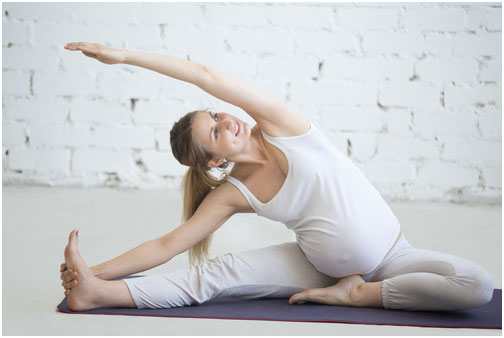What causes back pain?
There are a number of reasons for back pain in pregnancy. Here are the main ones.
- Ligament softening hormones like relaxin causes your joints to move more than usual, causing extra strain on your back and hips.
- Postural problems caused by your growing uterus and stretched abdominal muscles that restrict you from being able to maintain proper alignment.
- Your baby's weight causes your lower back to sway as your centre of gravity moves forward making back muscles short, tight, and painful.
- Position of your baby (particularly towards the end of pregnancy) can compress nerves and cause back pain.
- Emotional stress can cause muscle tension in the back, which may be felt as back pain or back spasms. You may find that you experience an increase in back pain during stressful periods of your pregnancy.
What can I do to relieve lower back pain?
When your back hurts, you may feel more like curling up in bed than exercising, but don't take to your bed for long periods. Bed rest is generally not helpful for lower back pain in the long run and may even make you feel worse. Exercise may actually be just what you need. Regular exercise strengthens muscles and boosts flexibility. That can ease the stress on your spine. Safe exercises for most pregnant women include walking, swimming , and stationary cycling. Your doctor or physical therapist can recommend exercises to strengthen your back and abdomen.
Improve your posture
As your baby grows, your center of gravity shifts forward. To avoid falling forward, you might compensate by leaning back — which can strain the muscles in your lower back and contribute to back pain during pregnancy. Keep these principles of good posture in mind:
- Stand up straight and tall.
- Hold your chest high.
- Keep your shoulders back and relaxed.
- Don't lock your knees.
When you stand, use a comfortably wide stance for the best support. If you must stand for long periods of time, rest one foot on a low step stool — and take time for frequent breaks.
Good posture also means sitting with care. Choose a chair that supports your back, or place a small pillow behind your lower back.
Shoes
Wear comfortable shoes and make sure your shoes have good arch support. Put away your high heels for a while because as your belly grows and your balance shifts, high heels will throw your posture even more out of whack and increase your chances of stumbling and falling.
Lift properly
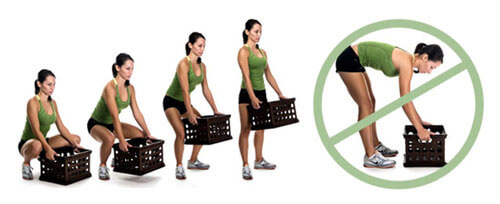
When lifting a small object, squat down and lift with your legs. Don't bend at the waist or lift with your back. It's also important to know your limits. Ask for help if you need it.
Sleep on your side
Sleep on your side, not your back. Keep one or both knees bent. Consider using pregnancy or support pillows between your bent knees, under your abdomen and behind your back.
Deep heat
A simple massage can be heavenly when you're suffering from pregnancy back ache torture. Ask your partner to rub your back or indulge in a pregnancy massage. Pregnancy massage is specially designed to alleviate swelling and reduce stress on weight bearing joints.
Heat packs can also alleviate back pain by improving blood flow to your aching muscles which encourages them to relax. Simply apply the heat pack for approximately 15-20 minutes to your sore back as often as every 3-4 hours. Be careful not to overheat your body though - heat packs shouldn't be hot but feel comfortably warm against your body.
Kegel exercise
To exercise the pelvic floor muscles, try to envision pulling the muscles of the vaginal area up and in towards your baby. You should not feel your buttocks, thighs, or abdominals tightening as you do this.
Wall Squats

Stand with your head, shoulders, and back against a wall with your feet about 1 to 2 feet away from the wall. Press your lower back into the wall and squat as if you were going to sit down, with the knees approaching a 90-degree angle. Come back up slowly, keeping your back and buttocks in contact with the wall.
Triangle Pose
Stand with feet wide, right foot turned out and right heel aligned with arch of left foot; raise arms to shoulder height and out to sides, palms facing floor.

Bend forward from the hips over right leg, placing your right hand on your shin or ankle, as you extend your left arm toward the ceiling, palm facing forward; turn head to look up at ceiling. Hold for 10 to 30 seconds. Repeat on opposite side. Strengthens: Legs; stretches back and legs.
Seated Tick Tocks
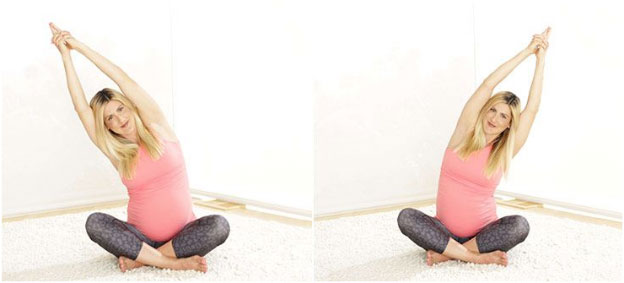
How these help ease back pain: Stretching and strengthening both play key roles in reducing and/or eliminating back pain, and this move gives you both! If the pain you’re experiencing is on the sides of your back, this move should provide some immediate relief as well as help tone and strengthen those muscles to prevent future pain.
How to do this exercise: Sit in a comfortable seated position with legs crossed. As you lean over to one side with your arms extended overhead, you will be stretching one side of your back while contracting the other side. Hold that stretch for just a moment while inhaling a deep breath, and then exhale the air out as you contract the elongated side, return through center, and stretch to the other side.
Bent-Over Front Raises
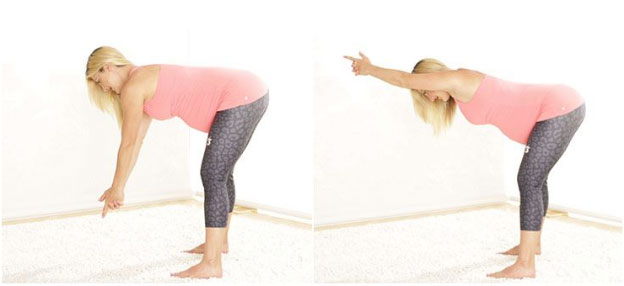
How these help ease back pain: Weak back muscles that are unable to hold the weight of your growing belly are a primary cause of back pain. It can be difficult to find exercises that can strengthen your back without using weights, machines, or belly down exercises, which are contraindicated for pregnancy. This exercise is safe for anyone at any fitness level and can be done without any equipment. The weight of your arms over your head is enough to strengthen your back but light enough to prevent injury.
How to do this exercise: Begin by hinging at the waist to form a bent-over position; your back should be parallel to the ground or slightly higher. Clasp your hands together with your pointer fingers pointed towards the ground. Raise your arms up until they are also parallel with floor.
Glute Bridges
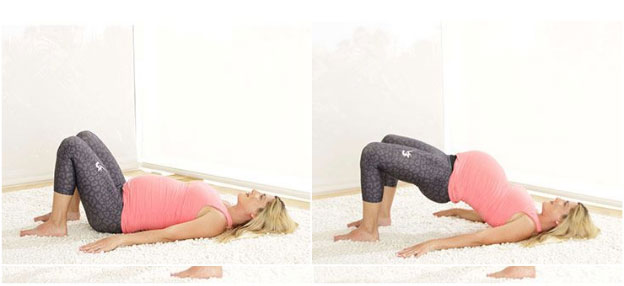
How these help ease back pain: Weak glutes (butt muscles) are another cause of pregnancy-related back pain. When pregnant, we often spend a lot more time sitting than standing, squatting, or walking up stairs. This leads to weaker than usual glute muscles.
How to do this exercise: Begin by lying flat on the ground with your arms down by your sides. Bend your knees and plant your heels on the floor close to your butt. Now press your heels into the floor to raise your butt up off the floor, forming a bridge shape with your body. Squeeze your butt and back muscles at the top, and then slowly lower back down to the ground.
How many? 3 sets of 15 reps
Child’s Pose
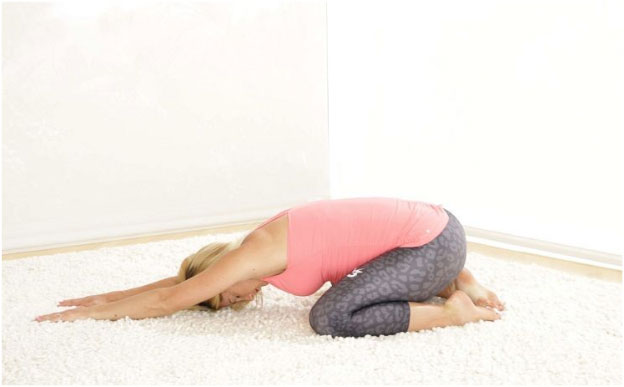
How these help ease back pain: Child’s Pose is more of a stretch than an exercise, but it certainly feels great for the back and is a great way to cool down from all the strengthening work you just did. The elongation of the spine in this pose helps relieve pressure on surrounding nerves.
How to do this exercise: Start in an all-fours position and open your knees wide apart. Sit your butt back and down as low as you can go until you can relax your weight down, allowing your back to round. Stretch your arms all the way out in front of you on the floor. If this feels uncomfortable with your baby belly in the way, you can rest on bent elbows.
How many? Hold this stretch for 1-2 minutes as a cool down stretch.
By incorporating these exercises into your weekly routine you can greatly reduce or eliminate pregnancy related back pain.
Goddess
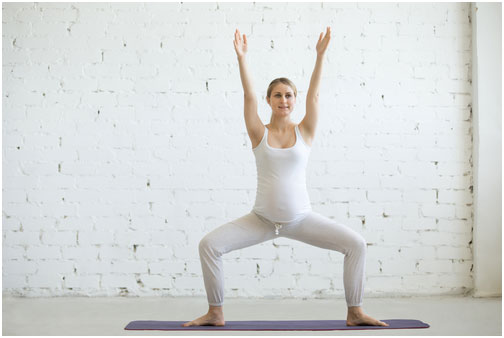
This yoga pose requires strong legs and works to open up the hips. It’s a great stretch if you’re stuck sitting at your desk all day.
Position your feet about three feet apart, toes facing outward. Bend both knees to enter a squat position. Raise your hands above your head, palms facing inward. Hold and breathe deeply for several seconds.
Butterfly
Time to move on to floor exercises that open your waist and pelvis while stretching the hips.Sit on the ground, bend your knees, and press the soles of your feet together. Pull your heels in as tightly to your body as you can, keeping your knees close to the floor. If your belly isn’t too big, lean forward to deepen the stretch.
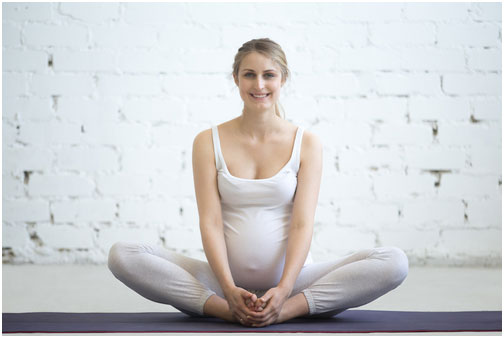
From the Butterfly position, extend your right leg outward, keeping the left leg tucked in. Reach toward your foot with your right arm and extend your left arm above your head. Hold for several seconds while taking deep breaths. Release and repeat on the other side
